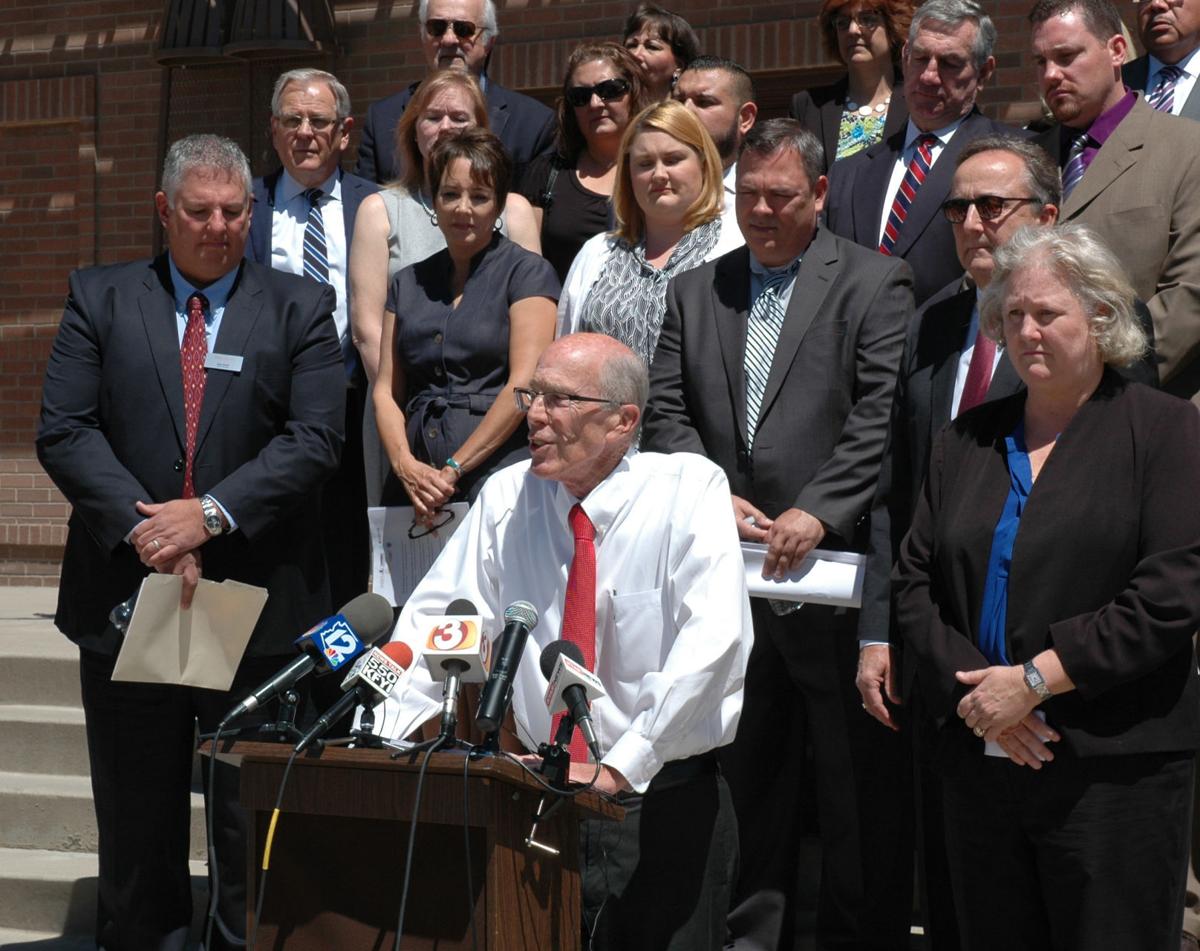GLENDALE — Calling the governor’s $17 million offer of capital funds “trivial,” the lead attorney for school districts said Monday it will take a court order to force the state to live up to its constitutional obligations to build and repair schools.
Tim Hogan said the state Supreme Court made very clear in rulings in 1994, 1997 and 1998 that these burdens cannot be borne solely by local taxpayers.
“The state has to provide the funding for school buildings and equipment to meet the minimum adequacy standards,” he said. “And they’re not doing that.”
Hogan, in filing suit against the state, pegged those obligations at close to $300 million a year; with prior years’ shortfalls, he said the lost dollars now total about $2 billion.
Gov. Doug Ducey, speaking separately to reporters, defended his budget proposal.
The governor said the state was running a $1 billion a year deficit when he took office in January 2015. He said the state is doing the best it can to fund not only education but all its needs.
Hogan said the Republican-controlled Legislature in 2011 cut corporate tax rates by close to 30 percent and set up a system under which some multi-state corporations owe no taxes at all.
These were approved even while the state was running a deficit. And while Ducey was not governor at the time, he has made no effort to delay their implementation.
The net result is that corporate tax collections, which were $663 million in 2015, will drop to $263 million by 2020.
Hogan rejected Ducey’s contention the state is putting as much money into K-12 education as is possible. Hogan said the Supreme Court made it clear in its prior rulings that capital funding isn’t a discretionary item that lawmakers can fund only when they say they have sufficient dollars.
“And if you need to generate additional revenue to comply with the constitution, then that’s what you need to do,” he said.
Hogan conceded the Supreme Court does not have the power to order lawmakers either to raise taxes or rescind prior tax cuts. But he said justices do have a way to enforce their orders if they conclude lawmakers are not following the state constitution.
That’s what happened in 1998.
Hogan, involved in that lawsuit, said he asked for — and the justices finally set — a deadline, giving lawmakers 60 days to bring the school finance system into compliance with what the constitution requires. The justices told lawmakers unless they come up with an acceptable plan, they would block the state treasurer from distributing funds to schools, effectively shutting them down.
It worked: Lawmakers enacted formulas for ensuring new schools were built when needed and provided a regular flow of dollars for maintenance — the formulas they have since repealed and refused to fund.
“And if that’s really what legislators and the state want, I suppose that’s what the courts would have to go through again,” Hogan said.
Ducey said questions about that $400 million a year in tax cuts are missing the point.
“The state is also one of the fastest-growing states in the country,” he said.
“We’re standing in the fastest-growing county in the country,” Ducey continued. “So we’ve got a lot of positives going for us.”
And he said the final budget, expected to be adopted this week, will be “a home run for education,” even if it has nowhere close to the amount the schools contend the state is required to provide.
Ducey also insisted the $400 million in annual tax cuts was not a mistake.
The governor said he met with CEOs and business owners who were in Arizona for Super Bowl, the NCAA Final Four and other sports events.
“One of the major questions they all have is about the economic attractiveness: What is the tax burden that we have, what are our regulatory burdens that we have,” the governor said.
“These are all things that are important in growing the state and growing the state’s economy so we can invest in education, we can grow the state’s economy, we can bring people to the state of Arizona,” Ducey continued. “That’s the message we campaigned on, that’s been our record since we came into office.”
Conversely, they governor said he’s heard no concern about Arizona being near the bottom of all states in per-student funding.
“I happen to know some people in the business community,” he said. “And I would say the business community shares my commitment to K-12 education.”
Hogan said the $17 million offer by Ducey to take care of the capital needs of more than 2,000 schools around the state tells another story.
“That $17 million is trivial when compared to the overall capital needs of schools in Arizona,” he said. Hogan said Glendale Elementary School District, where the lawsuit was announced, has $50 million in unmet needs alone.
But the ultimate bottom line, Hogan said, is the simple fact that there are not one but three Supreme Court rulings that say the state cannot derail the financial burden of new schools and repairs to local taxpayers. He said that’s where the state was in 1994 — and where the state again is since 2013 when lawmakers repealed the funding for both.
He said some schools have met capital needs with the money they’re supposed to use for basic operations. But that, Hogan said, takes away dollars that can be used to shrink class sizes and improve teacher pay.





